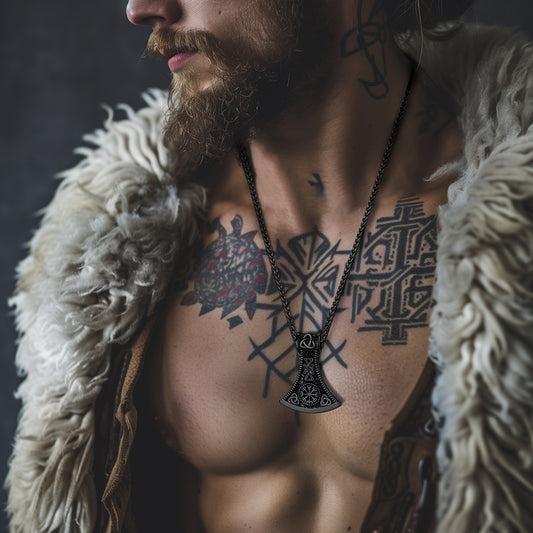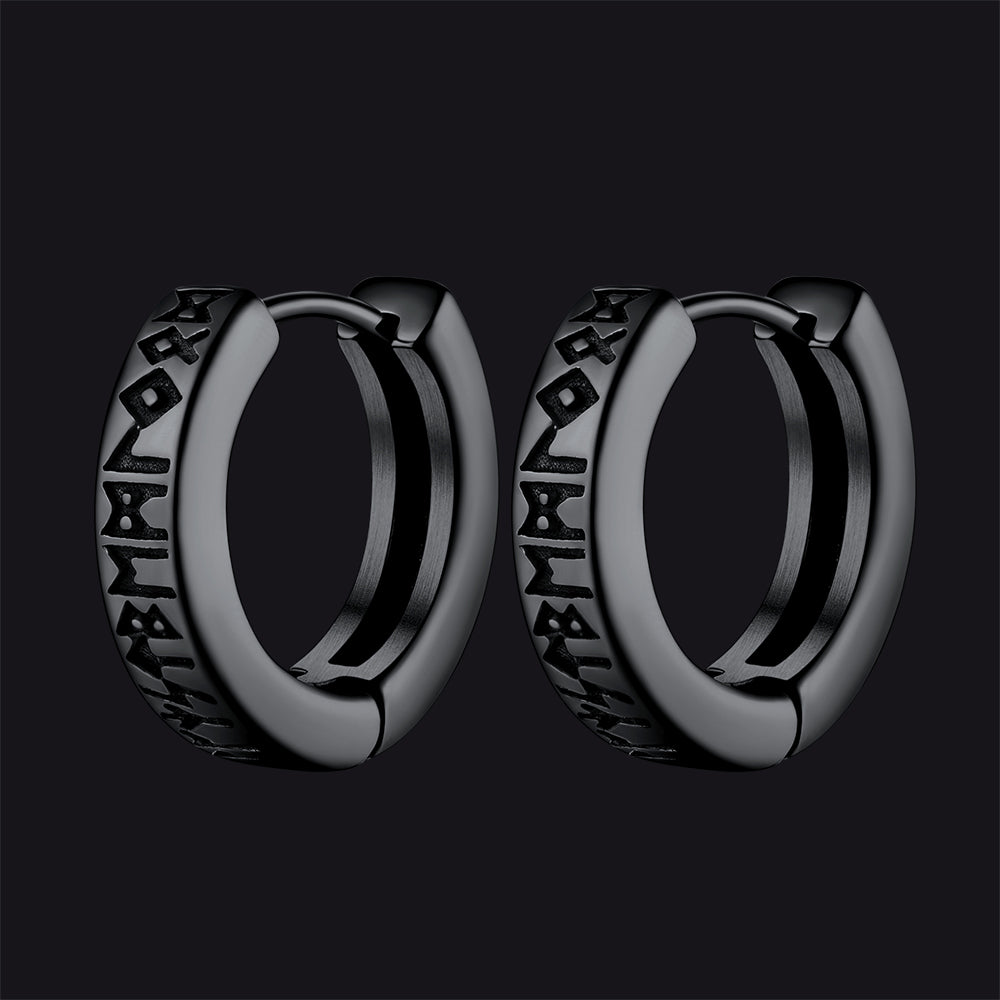The Ultimate Guide To Growing And Styling Your Viking Beard
A Viking beard is not just a statement facial hairstyle—it's a cultural symbol associated with Norse identity, masculinity, and individual strength. From the frozen fjords of Scandinavia to contemporary streets filled with barbers and Nordic-themed festivals, the Viking beard is still a mark of power and fashion. In this article, you'll discover what qualifies a beard as "Viking," how to grow and style one, the adornments that take it to the next level, and how to work it into an overall appearance.
Viking Axe Compass Necklace
What Is a True Viking Beard? Origins, Meaning, and Classic Norse Styles
How Did Vikings Groom Their Beards?
Vikings did not simply sport beards due to the chill—they grew them with intention. Archaeological evidence, sagas, and surviving combs indicate that Norse men were serious about grooming. Beards signified age, social status, and honor. Cleanliness and presentation were important. In fact, most Viking warriors wore combs and tweezers into battle.
What Did Beards Symbolize in Viking Society?
A flowing, well-maintained beard was also a sign of virility and authority. Norse deities such as Odin and Thor were always portrayed with powerful beards—emblems of strength and wisdom. For warriors and sailors, facial hair was associated with rites of passage, familial pride, and even superstition. For many, the beard had become a visual statement of identity and valor.
Common Beard Styles Among Vikings
Though not all Vikings sported the same beard, a number of styles have become historically associated with the culture:
- The Full Beard with Mustache: A thick natural growth that runs the length of the jawline and chin.
- The Forked Beard: A favorite among warriors, usually braided or with metal beads.
- The Braided Chin Beard: A longer version with one or two recognizable braids, typically paired with a clean neckline.
- The Short Beard with Defined Edges: Preferred by ship captains or traders—neat, intentional, and practical.

How to Grow a Viking Beard from Scratch And Make It Thrive
Viking Beard Growth Timeline: Month-by-Month Expectations
| Timeframe | Beard Development | What to Expect | Care Tips |
| Week 1–2 | Stubble Stage | Short, rough stubble appears. May feel itchy or prickly. | Cleanse daily; use a soothing balm to reduce irritation. |
| Week 3–4 | Itch & Patch Phase | Itchiness continues. Patches and asymmetry are common. | Moisturize with beard oil; resist the urge to trim. |
| Month 2 | Early Beard Formation | Growth becomes more visible; neckline starts to shape. | Begin light shaping under jawline; comb daily. |
| Month 3 | Mid-Length Viking Base | Beard reaches ~1.5–2 inches; sides fill in slowly. | Trim strays; introduce a beard brush to train growth. |
| Month 4–5 | Bulk & Density Phase | Beard thickens; shape becomes more defined. | Deep condition weekly; trim mustache edges if needed. |
| Month 6+ | Full Viking Beard Potential | ~3+ inches long; style potential begins (braids, rings, etc.). | Shape with precision; consider beard jewelry or wax. |
Keep Your Beard and Skin Healthy for Better Growth
Healthy skin equals healthier beard growth. Cleanse with a beard-friendly cleanser twice weekly to minimize buildup. Finish with beard oil containing jojoba or argan oil to lock out dryness and itch. Massage your face to stimulate hair follicles and increase blood flow.
Basic Grooming Equipment
- Beard Comb: For oil distribution and detangling.
- Boar Bristle Brush: Shapes the beard and trains the growth direction.
- Beard Scissors or Trimmer: Maintain a clean neckline and split ends.
- Beard Balm or Wax: Provides structure, particularly useful for longer or braided styles.
Shaping And Sculpting Tips
Trim loose hairs bi-weekly. Define the cheek line and neck line closely—don't let it run too far down the neck. For Viking realism, allow the body of the beard to be natural, but make it symmetrical. You don't need sharp edges, but deliberate shaping is important.

How to Style Your Viking Beard with Authentic Norse Jewelry: Practical Tips
Tip 1: Learn From Viking Traditions
- Viking warriors used beard rings made from bronze, silver, or iron to secure braids or signify status.
- Historical finds in Sweden and Denmark show beard beads etched with runes, animal motifs, and clan symbols—ideal inspiration for today’s beard styles.
Tip 2: Choose The Right Modern Beard Jewelry
- Stainless Steel or Bronze Beads: Great for durability and bold Norse designs like Thor’s hammer, raven heads, or knotwork patterns.
- Elastic-Backed Rings: Easy to insert and remove; excellent for everyday wear without tugging on your beard.
- Runestone Clips or Pins: Better suited for thicker braids, offering both weight and a strong historical vibe.
Tip 3: Match Metals to Your Outfit and Accessories
- Use silver beard beads if you wear sterling silver rings, pendants, or arm rings.
- Pair bronze or brass pieces with leather bands, rugged watches, or vintage belt buckles.
- Stick to consistent symbols like Mjölnir (Thor’s Hammer) or Vegvisir (Viking compass) for a unified and powerful look.
How Do You Maintain A Viking Beard And Jewelry In The Long Term?
Daily And Weekly Maintenance Rituals
A beard that is clean grows better and appears stronger. Brushing every day stops tangling and keeps oils spread evenly. Apply beard oil every morning and balm at night to seal in moisture. Shampoo it with a beard shampoo once or twice weekly.
Cleaning Beard Beads And Rings
Metal beard jewelry can trap sweat, oil, and dirt. Every few days:
- Gently remove the beads.
- Rinse with warm soapy water.
- Dry and polish using a soft cloth.
- Avoid sleeping with beads to help avoid breakage.
Storing Jewelry And Beard Tools
Store beard beads in a cloth bag to avoid tarnishing. Place scissors, combs, and oils in a cool, dry area. Change products every 6–12 months, particularly if they have natural oils that can become rancid

How Can You Incorporate A Viking Beard Into Your Overall Style?
Clothing That Suits The Viking Look
Your beard will say a lot, but the rest of your style can enhance or conflict with it. Select apparel that reflects the wild, formal sophistication of Norse custom:
- Natural Fibers: Leather, linen, or wool create an earthy, natural feel.
- Layered Looks: Cloaks, tunics, or layered coats evoke the warrior spirit.
- Boots And Belts: Wide leather belts and lace-up boots complement full beards and jewelry.
Contemporary Attires Suitable For A Viking Beard
You don’t have to dress like you stepped off a longship every day. A Viking beard also pairs well with:
- Henleys, flannel shirts, or heavy hoodies.
- Raw denim or cargo pants.
- Minimalist gray or black attire with understated jewelry details.
Hair And Beard Coordination
If you have long hair, try braiding small bits or pulling it back to mimic the shape of the beard. If you have short hair, a fade or undercut will allow the beard to take center stage. Coordination between the hair and beard in terms of grooming makes the overall style feel more integrated.
The Viking Beard: A Symbol of Identity and Heritage
The Viking beard is not merely a matter of growing a beard—it's a matter of growing identity. From its historical origins to its contemporary interpretation, the process of growing a Viking beard requires patience, intention, and style. With the proper tools, grooming practices, and traditional adornments, your beard can serve as a homage to Norse heritage and an expression of personal vigor.
5 FAQs about Viking Beard Grooming and Styling
Q1. Can I Grow A Viking Beard If I Have Patches Facial Hair?
A: Yes, but it requires more planning. If your beard grows in patchy, work on creating a density by cutting it evenly, with the weaker spots catching up. Use growth-stimulating products such as beard oils containing castor oil, and do not shave too often. A shorter but well-shaped beard can still achieve the Viking appearance when combined with assertive styling and accessories.
Q2. Do Beard Beads Hurt Hair Or Lead To Breakage?
A: Beard beads do not necessarily hurt hair, but misuse can. Tying them too tightly, sleeping with them on, or using low-quality materials can lead to split ends or hair loss. Always put beads in gently, leave space between them to prevent tension on individual strands, and take them out at night. Select beads with smooth interior surfaces so they do not snag.
Q3. Does A Viking Beard Have To Be Braided?
A: No. Although braiding contributes to the timeless Viking look, it's not necessary. Some Norsemen in history probably had their beards unbraided but neatly groomed. A dense, shaped beard without braids can still evoke the Viking look—particularly when paired with Norse jewelry, striking clothes, and a rigorous grooming regime.
Q4. How Long Must My Beard Be Before I Use Beads Or Rings?
A: Ideally, your beard needs to be 4–5 inches or more in length before trying beads. This provides stable braiding and sufficient thickness to secure a bead without it slipping out. If you fall between lengths, use leather wraps or smaller accessories until such time that your beard reaches a length suitable for metal rings.
Q5. Is It Possible To Wear Viking Beard Jewelry In A Corporate Or Formal Environment?
A: It's up to your workplace. For creative or casual environments, a small bead or ring can be an interesting conversation piece. For more formal workplaces, go for more subtle grooming and take off decor during working hours. Look for accessories that are simple to insert and take out without disrupting your beard design.





